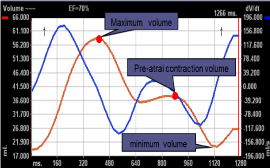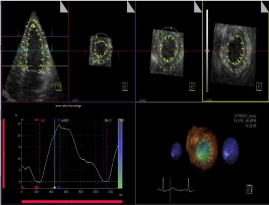
Clinical Image
Austin Med Sci. 2016; 1(3): 1011.
Bedside Ocular Ultrasound for Diagnosis of Visual Disturbances in Hypertensive Disorders of Pregnancy
Dominguez D¹*, Rodriguez A¹, Arias J¹, Rodriguez R² and Hernandez R¹
¹Department of Anesthesiology and Surgical Critical Care, Universitary Hospital Ntra. Sra de Candelaria, Spain
²Department of Ophthalmology, Universitary Hospital Ntra. Sra de Candelaria, Spain
*Corresponding author: Dominguez D, Department of Anesthesiology and Surgical Critical Care, Universitary Hospital Ntra. Sra de Candelaria, Tenerife, Spain
Received: September 12, 2016; Accepted: September 15, 2016; Published: September 16, 2016
Clinical Image
A 41 year-old woman in her first pregnancy attended our emergency department due to high blood pressure, headaches and visual disturbances. She was taken to the operating room for an emergency caesarean section. In postoperative she developed HELLP syndrome. Due to the persistence of the headaches and visual disturbances, an ocular ultrasound was performed which showed, in both eyes, a laminar hyperechogenic image in the vitreous cavity compatible with bilateral serous retinal detachment (Figure 1). Measurement of the diameter of the optic nerve sheath was similar in both eyes, 5, 4mm in the right eye and 5, 5mm in the left eye, which was indicative of increased intracranial pressure [1-4]. A Cranial CT scan was performed and was normal. In the following days, blood pressure was controlled and the headaches and visual disturbances were no longer present. An ocular ultrasound no longer showed images of retinal detachment nor increased intracranial pressure (Figure 2). We believe that bedside ocular ultrasound is a useful tool in hypertensive disorders that are associated with visual disturbances.

Figure 1: Ocular ultrasound of the right eye: (*) a laminar hyperechogenic
image in the vitreous cavity compatible with retinal detachment. (**)
Measurement of the diameter of the optic nerve sheath (taken 3 mm behind
the retinal edge) was 5, 4mm which was indicative of increased intracranial.
This finding was also seen in the left eye.

Figure 2: Ocular ultrasound in the following days with antihypertensive
treatment without headaches and visual disturbances. In right eye no showed
images of retinal detachment nor increased intracranial pressure, optic nerve
sheath was less 5mm, exactly 4, 2mm taken 3mm behind the retinal edge
(**). Ultrasound in the left eye was also normal.
References
- Amin D, McCormick T, Mailhot T. Elevated intracranial pressure diagnosis with emergency department bedside ocular ultrasound. Case Rep Emerg Med. 2015; 2015: 385970.
- Ohle R, McIsaac SM, Woo MY, Perry JJ. Sonography of the optic nerve sheath diameter for detection of raised intracranial pressure compared to computed tomography: a systematic review and meta-analysis. J Ultrasound Med. 2015; 34: 1285-1294.
- Qayyum H, Ramlakhan S. Can ocular Ultrasound predict intracranial hypertension? A pilot diagnostic accuracy evaluation in a UK emergency department. Eur J Emerg Med. 2013; 20: 91-97.
- Rajajee V, Vanaman M, Fletcher JJ, Jacobs TL. Optic nerve ultrasound for the detection of raised intracranial pressure. Neurocrit Care. 2011; 15: 506- 515.